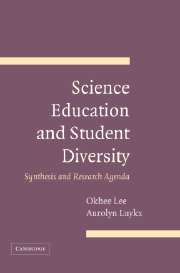Book contents
- Frontmatter
- Contents
- Foreword by Roland G. Tharp
- Acknowledgments
- Introduction
- SECTION I CONCEPTUAL GROUNDING AND POLICY CONTEXT
- SECTION II STUDENT LEARNING AND CLASSROOM PRACTICES
- SECTION III CREATING EQUITABLE LEARNING ENVIRONMENTS
- SECTION IV CONCLUSIONS AND A RESEARCH AGENDA
- Appendix: Method for Research Synthesis
- References
- Index
Appendix: Method for Research Synthesis
Published online by Cambridge University Press: 04 December 2009
- Frontmatter
- Contents
- Foreword by Roland G. Tharp
- Acknowledgments
- Introduction
- SECTION I CONCEPTUAL GROUNDING AND POLICY CONTEXT
- SECTION II STUDENT LEARNING AND CLASSROOM PRACTICES
- SECTION III CREATING EQUITABLE LEARNING ENVIRONMENTS
- SECTION IV CONCLUSIONS AND A RESEARCH AGENDA
- Appendix: Method for Research Synthesis
- References
- Index
Summary
In selecting research studies for inclusion in this synthesis, a systematic review of the relevant literature was conducted according to the following parameters:
Direct relevance to the topic, that is, studies addressing the intersection between science education and student diversity in terms of race/ethnicity, culture, language, and social class.
Studies published since 1982. The landmark for science education reform was the release of the “Science for All Americans” document (AAAS, 1989). The period between 1982 and 2004 spans the years leading up to the release of this document (1982–1989) and more than a decade afterward (1990–2004).
Studies conducted within the United States and abroad, but limited to those published in English and focusing on settings where English is the main medium of science education.
Studies focusing on science education at the elementary and secondary levels (K–12). Studies involving postsecondary or adult learners are not included.
Empirical studies from different methodological traditions, including (a) experimental and quasi-experimental studies, (b) correlational studies, (c) surveys, (d) descriptive studies, (e) interpretative, ethnographic, qualitative, or case studies, (f) impact studies of large-scale intervention projects, and (g) demographics or large-scale achievement data.
Literature reviews and conceptual pieces.
Within these parameters, the synthesis includes journal articles, books and book chapters, and technical reports. The process of gathering studies from the various sources was carried out as follows:
First, a search of the Education Resources Information Center (ERIC) database was conducted using the terms “science education” and “school” combined with the following key words: equity, diversity, minority, culture, language, race, and ethnicity.
- Type
- Chapter
- Information
- Science Education and Student DiversitySynthesis and Research Agenda, pp. 163 - 166Publisher: Cambridge University PressPrint publication year: 2006



